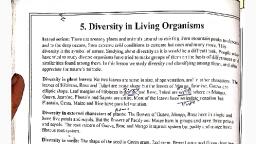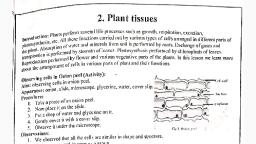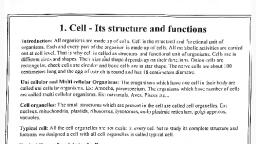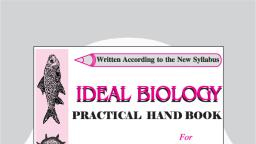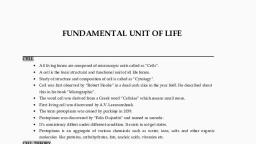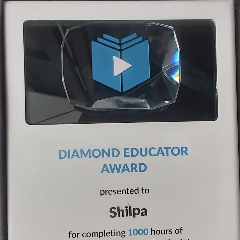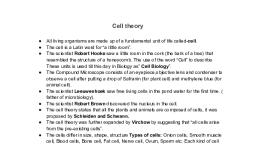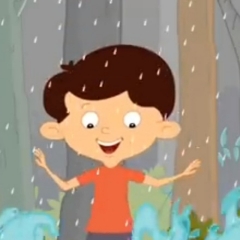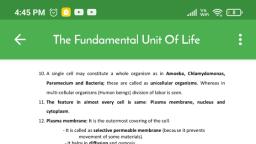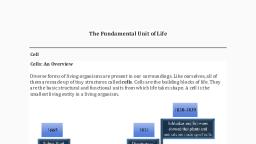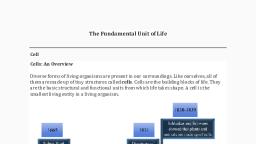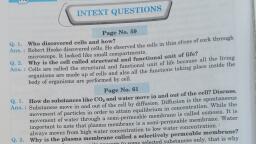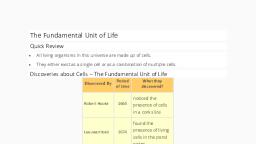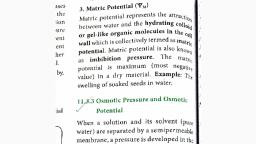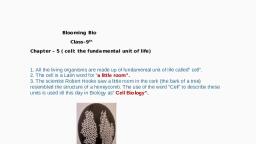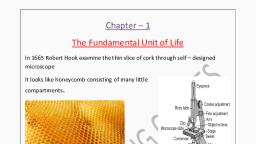Page 1 :
4. Plasma membrane, Introduction: Cell is the basic unit of life. Cell perfoms different functions. For this, it requires, diferent typcs of substances. 1he required substanees should go into the cells and waste material come, out of the cells. Osygen. ghucose. proteins, fats, minerals, vitamins and water should go into the cells, Carbon dioxide and wastes should come out of the cell. In this lesson, we lcarn how substances pass, through eells in Organisms., , Preparation of saturated solution (activity):, Aim: preparation of saturated sugar/salt solution., Material: water, beaker, sugar or salt., Procedure:, Take 100ml of water in a beaker., , ., , Add sugar/salt and stir till it is dissolved., 3. Repeat it till it will not dissolve., 4. This is the saturated solution of sugar/salt., 5. In this solution sugar/salt is the solute and water is the solvent., 2., , Which one is more concentrated solution: if we add various amount of sugar to the equal quantity of, water separately, the solution which is added more sugar has more concentration., , Observation of dry grapes / kishmish when kept, , in, , water (activity):, , in, Aim: Observation of dry grapes/ kishmish / Raisin when kept water., Material: beaker, water, dry kishmish., , Procedure:, , Take 100ml of water in a beaker., 2. Keep the dry kishmish in it., 3. Leave it for one hour., 4. Take out kishmish and observe it., kishmish., Observation: kishmish is swollen when compared to dry, kishmish., into, Inference: The water from beaker enter, 1., , kept in saturated solution (activity):, Observation of dry grapes/ kishmish / Raisin when in, saturated solution, kept, when, kishmislh, /, grapes, Aim: Observation of dry, Material: beaker, water, sugar, kishmish., Procedure:, in a beaker., , ., , Take 100ml of saturated sugar solution, 2. Keep fresh kishmish in beaker., in the next morning., 3. Leave it over night and observe, beaker shrinks and its size, in, the, kishmish, Observation: The fresh, into salt solution., Inference: the water from fresh grape enters, , Experiment to prove Osmosis, , in, , is, , reduced., , Potato (activity):, , Aim: to prove osmosis in potato., , T.S.N(9491720974), , 4., , Plasma membrane, , 25
Page 2 :
water, knife, sugar., Material: raw potato, two beakers, two pins,, Procedure:, , ., , Take the raw potato and prepare it as a cup., 2. Prepare saturated sugar solution., 3. Pour the sugar solution in the potato cup to a level., 4. Mark the level of sugar solution by piercing the pin., Keep the potato cup in beaker of water., 6. The potato cup should be dipped in water half of the height., Leave it for half an hour and observe it., 8. Repeat the experiment by taking sugar solution in the beaker ana water in tne potato cup., Leave it for half an hour and observe it., Observation: In both the situations, water moved towards the sugar solution., , Inference: The process of movement of water through plasma membrane from lower concentration to, higher concentration is called Osmosis., , Experiment to explain process of filtration (activity):, Aim: to prove the process of the filtration., Material: two beakers, funnel, filler paper, stand, sugar, rice flour., , Procedure:, I., 2., 3., 4., 5., , Attach funnel with filter paper to stand., Keep the beaker below the funnel., Prepare rice powder solution in a beaker., Add a drop of tincture iodine to the solution., Now pour the solution into the funnel., , Observation:, 1., , By filtration, water along with dissolved flour reaches the beaker, below the funnel., 2. Filter paper does not allow the undissolved flour, to pass through it., It is remained on filter paper., Inference: here the filter paper acts as plasma membrane. It allows water and, dissolved materials to, pass through it. But it will not allow certain materials to pass through it., , Osmosis: The process of movement of water through plasma membrane from, lower concentration to, higher concentration is called Osmosis. The dried vegetables/ carrots /, kishmish which are kept in, water become fresh is due to osmosis. These dried vegetables have less, water and high salt, concentration in their cells. When they are kept in water, the water go into, the vegetables through, plasma membrane by this process osmosis., , Plasma membrane: The outermost membranous covering of the cell that, separates its contents from, the external environment is called plasma membrane. The membrane, acts as a physical barier between, the organneles of a cell and the cytoplasm and also between the, cell and its surrounding environment., Properties of plasma membrane, 1. Impermeable: It does not allow some, substances to pass through it., 2. Permeable: It allow the substances both solute and, solvent to pass through it., 3. Semipermeable: The membrane is permeable, to solvent but prevents the passage, of solutes., 4. Selectively permeable: It allows the passage, of solvent an some selected solutes., Functions of Plasma membrane:, 1. Shape: Plasma membrane provides, a definite shape to the contents, of the cell., 2. Mechanical barrier: lt functions as, mechanical barrier that protects, the internal contents of, the cell, 3. Selectively permeable: Plasma membrane, determines what substances are, to be allowed entry, or exit from the cell., 4. Endocytosis: It helps the cell to engulf, food and other substances, from its external, environment by endocytosis., T.S.N(9491720974), , 4. Plasma membrane, 26
Page 3 :
5. Recognition: The recognition centres, , of plasma membrane help in tissue formation, distinction, of foreign substances and defence against microbes., 6. Flow of information: Plasma membrane provides flow, of information amongst different cells, of the same organism., 7. Osmosis: Osmosis occurs due to presence of tiny water channels in, the plasma membrane., 8. Cell continuity: At places plasma membrane of adjacent cells become, continuous to form, plasmodesmata and cell junctions., 9. Specialization: Plasma membrane gets modified to perform different functions. Ex:, Absorption in microvilli., , Exosmosis Endosmosis:, The process in which water molecules leave the cell is called Exosmosis., The process in which water molecules enter the cell is called Endosmosis., , Experiment on Exosmosis and Endosmosis (activity):, , Aim: to prove Exosmosis and Endosmosis., Material: Three beakers, salt, petridish, dilute Hel, two equal sized raw egg, cloth, a strip of paper,, table spoon., , Procedure:, , ., , 2., 3., 5., 6., 7., 8., , Keep the raw eggs in dilute Hel for 4 to 5 hours., The shells which are made of calcium carbonate are dissolved., Wash the eggs under a tap water., Measure the diameter of each egg with long strip of paper at their widest place., Prepare a concentrated salt solution in a beaker., Place one egg in the beaker with tap water and place the other in the salt water., Leave the beakers for 2 to 4 hours., Take the eggs out, wipe them and measure their diameter with the same strip of paper., , Observation:, , ., , The egg placed in salt water shrinks., 2. The egg placed in the tap water swells., , Inferenee:, , Shrinking of egg placed in the salt water is due to exosmosis. The water molecules come out of, the egg, The water molecules enter into, 2. Swelling of egg placed in the tap water is due to endosmosis., ege, the, 1., , Preparing Semi permeable membrane:, , ., , Take two raw eggs., , 5 hours., 4, 2. Keep the two eggs in dilute Hcl for to, in, Hcl., dissolved, 3. The shells are, 4. Wash the eggs under tap water., contents., 5. Make a hole to the egg membrane and drain out the, membrane., permeable, a, semi, It, as, acts, water., with, 6. Wash the membrane, , T.S.N(9491720974), , 4. Plasma membrane, , 27
Page 4 :
Experiment to prove Osmosis in egg membrane:, , to prove osmosis through semi permeable membrane of anegg, Material: two egg membrancs, three beakers, sugar, water, tred,, measuring jar, disposable syringe., , A, , Procedure:, , one egg membrane and fill it with 10ml ofsaturated sugar, Take, solution with a syringe., , 2., 3., 4., 5., , Tie its mouth with a tread., Keep the cgg membrane in 100ml of freslh water., Leavc it for ovemight., Take the second egg membrane and fill it with 10ml of tap watcr, with the syringe., 6. Keep this egg membrane in 100ml of saturated sugar solution., 7. Leave it for ovemight,, S. Measure the contents, of the cgg membranes and beakers., , Obscrvation:, , Egg membrane in fresh war, , entered into the cgg membrane in which sugar solution is filled. So size of the, Water, membrane, , increased., Water, lefi from the egg membrane in which water is filled. The size of the membrane is, decreased., erencc: Water moves across membranes from solutions of one concentration to the others through a, process called osmosis., , Removing salts from Sea water is called Desalination. Freddy Mercury and David Bowie removed, salts from sea water by using semi permeable membrane. When heavy pressure is applicd on salt, solution and the water is passed through semi permeable membrane, the water leave the salts and, become fresh water. This process is called Reverse Osmosis. Nowadays reverse osmosis machines aree, used domestically to filter salts and purify water., , Importance of Osmosis to living organisms:, 1., , 3., 4., 5., 6., , Water enters the roots through Osmosis., Water moves between the cells through Osmosis., It helps in opening and closing of stomata., It brings about movement of water and minerals in plants., In our body waste materials are filtered from the blood., In pur body useful materials are absorbed along with water through Osmosis., , Diffusion: The process by which some materials when kept in a medium like air and water, spread, equally throughout it is called Diffusion. Ex: If a bottle of scent is opened in one corner of a room, the, smell spreads in the entire room due to the diffusion ot scent molecules. Thomas Grah:am worked on, diffusion of gases in solutions. He had inferred that a more soluble substanees in a medium ditfuse, faster than a less soluble substance. This is popularly known as "Graham's Law"., , Observing Diffusion of coffee powder in water (activity):, Aim: Observing Diffusion of coffee powder in water, Material: bowl, coffee powder, water., Procedure:, Take half bowl of water., 2. Prepare a small ball of coflee powder., , ., , 3., , Slowly put, , in, , water and observe., , Observation:, , in, The ball of coffee powder starts dissolve water., iwill appear dark in colour., 2. The vater around the coftee powder, becomes coloured., the, in, beaker, water, the, all, passes, 3. As time, 1., , T.S.N(9491720974), , 4. Plasma membrane, , 28
Page 5 :
Initially pale in colour and slowly all the, water in the beaker becomes uniformly coloured., Inference: coffee powder molecules diffuse into the water forming uniform, colour., 4., , Observing Diffusion of Potassium permanganate in, water (activity):, Aim: Observing Diffusion of Potassium permanganate in, water, Material: potassium permanganate, petridish, water., , Procedure:, , 1. Keep a crystal, of potassium permanganate in a petridish., 2. Carefully fill the petridish with water., 3. Observe the movement of pink colour in, , Observation:, , the petridish every minute., , 1., , Potassium permanganate crystal starts dissolve in water., The water around the crystal will appear in pink colour., As time passes all the water in the beaker becomes coloured., 4. Initially pale in colour and slowly all the, water in the beaker become uniformly pink coloured., Inference: the potassium permanganate molecules move from, higher concentration to lower, concentration in water through diffusion., , Observing Diffusion of Copper sulphate in water (activity):, Aim: Observing Diffusion of Copper sulphate in, water, Matcrial: Copper sulphate, Petridish, water., Procedure:, Keep a small crystal of copper sulphate in a petridish., , ., , 2., 3., , Carefully fill the petridish with water., Observe the movement of blue colour in the petridish every minute., , Observation:, , I. Copper sulphate crystals start dissolve in water., The water around the crystal will appear in bluc colour., As time passes all the water in the beaker becomes coloured., Initially pale blue in colour and slowly all the water in the beaker become uniformly blue, coloured., Inferencc: The copper sulphate molecules move from higher concentration to lower concentration in, water through diffusion., 2., 3., 4., , ., , TEXTUAL QUESTIONS WITH ANSWERS, Fill in the blanks: (A.S-I), A. The structure which controls the entry and exit of the materials through the cell is, , membrane, , Cell, , B. The smell of flowers reaches us through the process of difftusion, C. The MIC gas of Bhopal tragedy spread throughout the city through the process of, , diffusion., D. Water enter into the potato osmometer due to a process called Osmosis., E. The fresh grape wrinkles, if kept in salt water because of Osmosis., , 2., , What do you mean by permeability of membrane? Explain with suitable example?(A.s-I), Allowing only certain materials to pass through the membrane is called permeability., Example, I. The cell membrane is very much pernmeable to gases such as carbon dioxide, oxygen,, nitrogen and fat solvent compounds such as alcohol, ether and chloropharm., 2. It is impermeable to polysaccharides, phospholipids and proteins., , 3., , If the dried vegetables are kept in water, they become fresh. What, , T.S.N(9491720974), , 4. Plasma membrane, , is, , the reason? (A.S-), 29
Page 6 :
in cells., and high salt concentration, , have less water content, d theyVegetables, are kept in water they absorb water and become ir, , nenwarer enter, c, , into the vegetables by a process known as osmosid, , ame the process by which we can get fresh water from sea wateter?, We, , 5., , (A.S-1), , can get fresh water from sea water by the process of reverse osmosid, , (A.S-I), , will happen to marine fish if kept in fresh water aquarium?, hat, The marine fish dies., , 1., , Reasons:, , Usually marine fishes have high concentration ofsalts in their body., they are kept in fresh water, the water from the fresh water aquarium enters the body, .When, of fishes, 3., , due to osmosis., More amount of fresh water enters the cells of fish. This result in bursting of cells and fish, , dies., 6., , Why do doctors administer saline (salt solution) only?, What will be happen, administer distilled water? (A.S-I), , if they, , .Injecting, , distilled water will cause to Hemolysis. Hemolysis is the rupture ofred blood, cells., 2. Large amount of distilled water would, cause to brain damage, cardiac arrest and deatn., 3. That is why distilled water is, not administered and saline only is injected., , 7., , What will happen if 50% glucose solution is injected intravenously, (into, 1. 50% of Glucose solution is, called dextrose., , n)? (A.S-II)D, , 2. If it is injected intravenously, it causes, to allergic reactions., 3. If also causes to infection at the joint site, tissues, necrosis, and venous thrombosis., 4. Hence concentrated dextrose should be diluted before injecting., 8., , What will happen if cells do not have ability of permeability? (A.S-II), . If the cells do not have ability of permeability, oxygen,, Glucose, proteins, fats, vitamins,, , are not entered into cells to perform metabolic activities., 2. The wastes are not excreted out from the cells, and they become as toxic., 3. So, if the cells do not have the ability of permeability, they, cannot perform the metabolic, activities. It finally leads to the death of the cells., 9., , What are your observations in experiments to know about diffusion? (A.S-III), , ., , Materials kept in medium (water/air) get dissolved in the medium., 2. These dissolved molecules gradually move in all directions., 3 They move from higher concentration to lower concentration., 4. This movement occurs till these molecules spread equally throughout, the medium., 10., , Discuss wvith your friends and write the list of incidences where diffusion, occurs? (A.S-4), 1. A sugar cube in a glass of milk/water diffuses, throughout it and makes it, sweet., 2. the smell of chicken curry diffuses throughout the house as they, are cooked., 3. Tea powder diffuses through the water to give it colour, and taste., 4. Air fireshner/deodorant molecules dilfuse into the air, when we put on, so, 5.Ifthe cooking gas is leaked, it spreads all over the house through diffusion.we can smell it., 6. CO bubbles in soft drink diffuse out of it, 7. Robbin Blue drops diffuse in water making the water blue., , T.S.N(9491720974), , 4. Plasma membrane, , 30
Page 7 :
8. Agarbathi, mosquito repellents work on the principle, 11., , of diffusion., , Draw the low chart showing different states in doing the experiment with cgg.? (A.S-5), Collection of required materials, Deshelling of eggs using dil. HCI, Collection of the egg membranes, Preparation of sacs with egg menmbrane, Filling of one egg membrane with 10 ml of saturated, Sugar solution and second one with 10 ml oftap water, , Tying their mouths with thread, Keeping the first sac in 100 ml tap water, And second sac in 100 ml satuarated sugar solution, , Leaving them for over night, , Measuring the contents of the egg membranes and beakers, Recording results, Draw conclusions., 12., , You have purchases a coconut in the market. By shaking it you found less water in it. Can, you fill the coconut with water without making a hole to the coconut? (A.S-7), 1. No, it is not possible to fill the coconut with water without making a hole., 2. The husk or shell of coconut is mostly made up of sclerenchyma cells which are dead., 3. Osmosis do not takes place in dead cells., , How diffusion is useful in everyday life? (A.S-7), it, it, A sugar cube in a glass of milk/water diffuses throughout and makes sweet., are, cooked., they, as, house, the, through, diffuses, curry, 2. the smell of chicken, it, 3. Tea powder diffuse through the water to give colour and taste., the air when we put on, so we can smell it., into, diffuse, molecules, freshner/deodorant, 4. Air, diffusion., 5. If the cooking gas is leaked, it spreads all over the house through, it., 6. CO bubbles in soft drink diffuse out of, blue., 7. Robbin Blue drops diffuse in water making the water, principle, diffusio., the, of, on, work, repellents, 8. Agarbathi, mosquito, (A.S-7), is involved?, 14. Give examples of four daily life activities in which osmosis, , 13., , ., , Water enters into the roots through osmosis., by kidneys., our body, waste materials are filtered from the blood, stomata., closing, and, in, of, the opening, 3. Osmosis helps, 4. Wilted vegetables become fresh by osmosis., 1., , 2., , In, , T.S.N(9491720974), , 4. Plasma membrane, , 31
